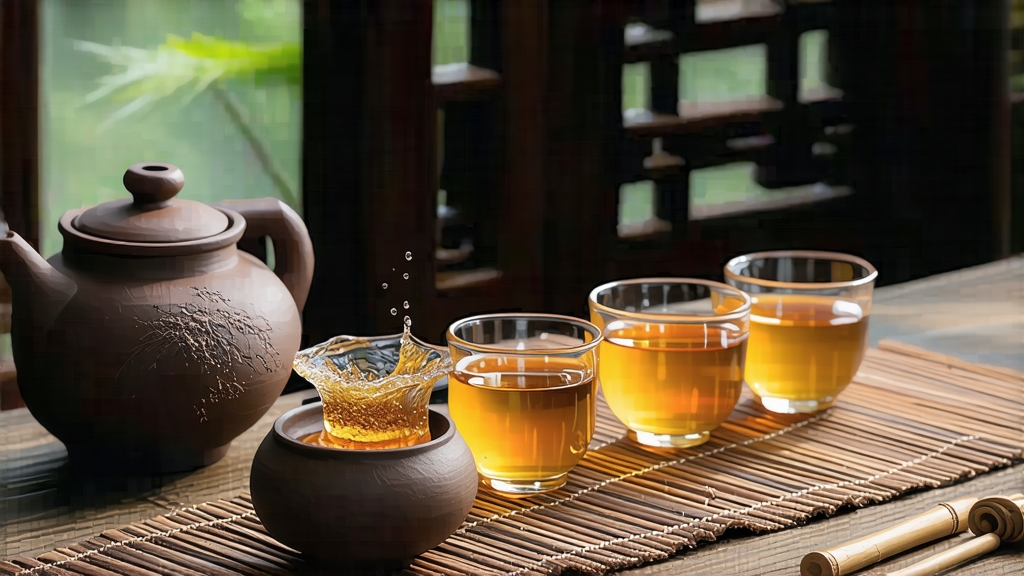
Tucked into the humid folds of southern Guangxi, where the Xun River winds beneath karst peaks veiled in perpetual mist, Liupu dark tea (often written Liu Bao) has quietly matured for five centuries. To the casual observer it is merely another brick of dark matter wrapped in bamboo; to the initiated it is a living archive of Ming-dynasty trade routes, of horse hooves and river junks, of camphor-scented storehouses whose cedar beams have absorbed five hundred monsoons. Liupu is the tea that sailed south to Malacca and north to the Mongolian steppe, the tea that Chinese medicine prescribed for “dispelling damp,” and the tea that Malay tin miners brewed thick as coffee to prevent malaria. Today it is being rediscovered by specialty cafés from Brooklyn to Berlin, yet its story is still best told in the dialect of Wuzhou, where the first character of its name—六堡—literally means “six fortresses,” a reference to the six hamlets that once pooled their leaf to fill the imperial quotas.
Historical Footprints
The earliest written record appears in 1541, in the local gazetteer of Cangwu County: “The people of Liupu present dark tea as tribute; its liquor is red as cinnabar and sweet as longan.” By the Qing, Liupu had become a currency of its own. A single bamboo-bound basket—30 kilograms of compressed leaf—could barter for a bolt of silk or a month’s lodging for a caravan. When the British opened Hong Kong as a free port, Liupu slipped outward: dockside signboards in 1872 list “Lau-Pow Tea” alongside Assam and Ceylon, priced by the picul for export to Java and Sumatra. In 1950 the state requisitioned the remaining private workshops, standardized the leaf grade, and built the First Liupu Tea Factory whose long brick warehouses still exhale the perfume of 1958 harvests whenever the heavy wooden doors are prized open.
Micro-Terroir
Guangxi’s climate is a mobile sauna: 85 % humidity, 22 °C average, 1800 mm of rain squeezed into 200 days. The indigenous Da Ye cultivar—literally “big leaf”—has evolved extra stomata on the underside of each blade to exhale moisture faster. The soil is lateritic, iron-rich and acidic, stained the color of dried blood by millennia of decomposed fern. These conditions breed a leaf that is already halfway to fermentation before it is even plucked; the cell walls soften under their own enzymatic weight, and the precursor molecules that will later generate Liupu’s signature betel-nut aroma lie dormant like spores waiting for the steam basket.
Pluck & Withering
Harvest begins at Qingming when the first three leaves unfurl to the width of an old copper coin. Pickers work barefoot, singing call-and-response couplets that mark time better than any watch. The leaf is carried in wicker back-baskets lined with banana leaf to prevent bruising, then spread on split-bamboo trays set on the second floor of the village longhouse. Here it wilts for eight hours beneath a ceiling of blackened thatch; the goal is 65 % moisture loss, judged by the veteran master who rolls a single leaf between thumb and forefinger until it curls like a shrimp yet does not snap.
Kill-Green by Steam, not Wok
Unlike green tea, Liupu is not pan-fired. Instead, the withered leaf is piled 20 cm deep into square cedar steamers and subjected to 98 °C saturated steam for exactly 90 seconds. The heat denatures polyphenol oxidase but leaves a halo of residual moisture that will jump-start the microbial waltz to come. The leaf emerges glossy, jade-black and hot to the touch; workers toss it into the air with shovels, letting the night breeze cool it while they chant the rhyme “steam high, pile low, turn twice, no more.”
Rolling & Pile-Fermentation
While still warm, the leaf passes through a mechanical roller whose spiral ribs twist each blade into tight cords, rupturing 30 % of the cell walls without breaking the surface. The wounded leaf is then heaped into rectangular piles one meter high on cement floors painted with copper sulfate to discourage harmful molds. A thermocouple probe is thrust into the heart; when the